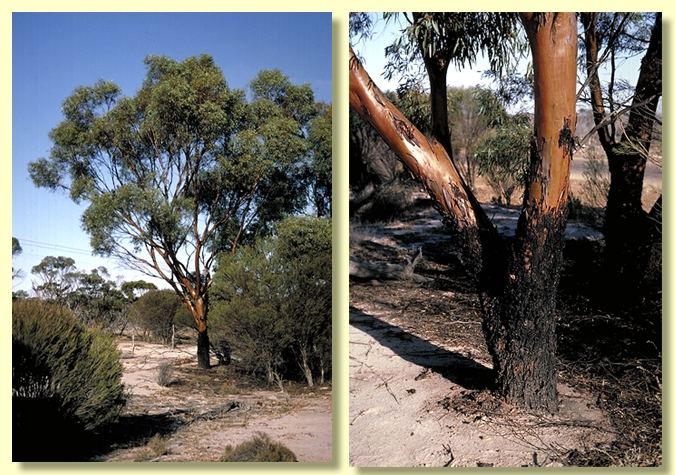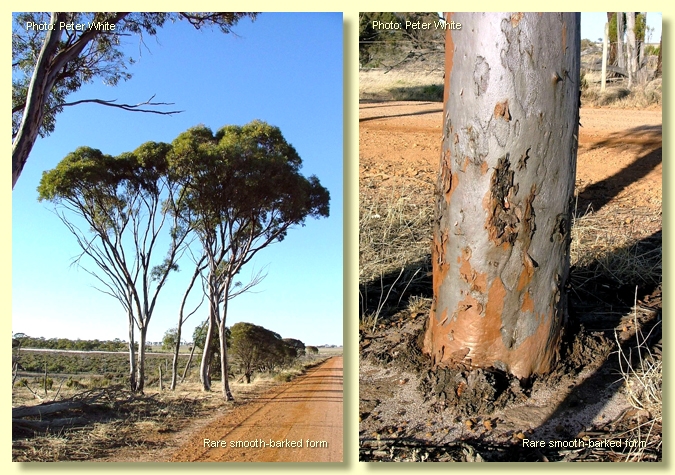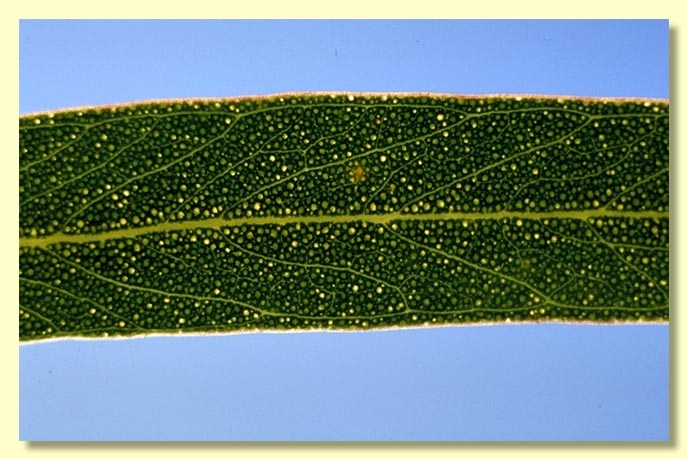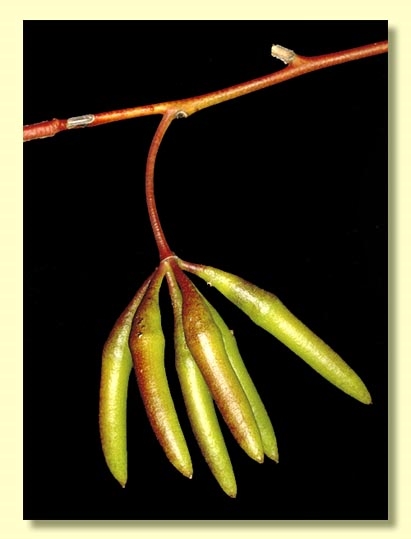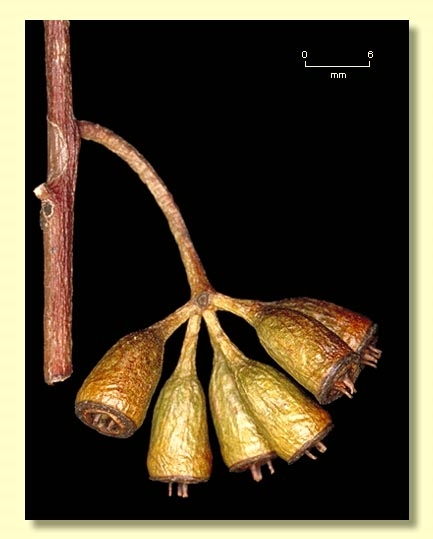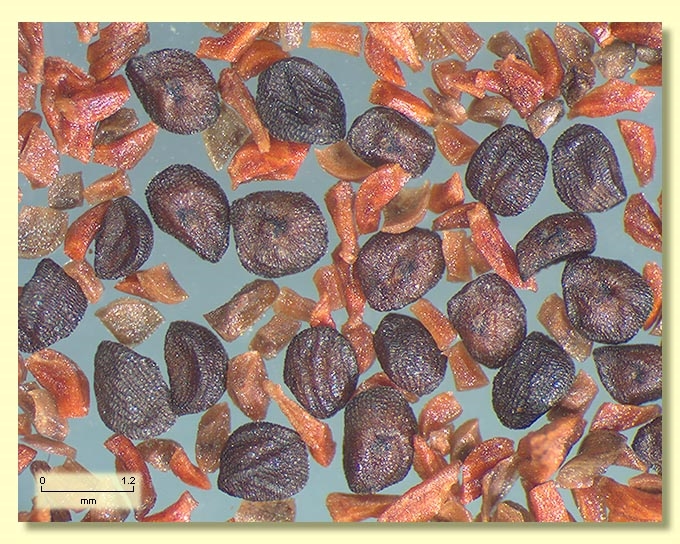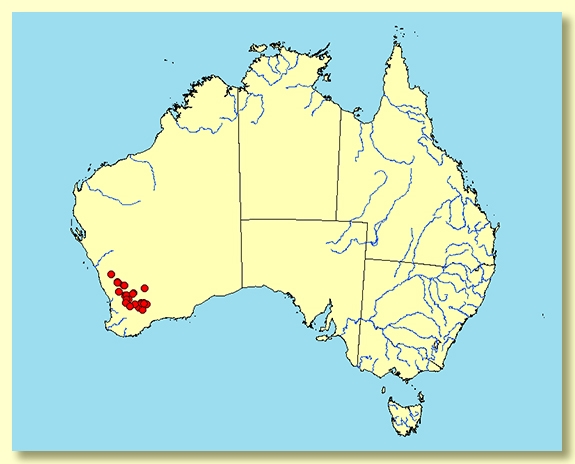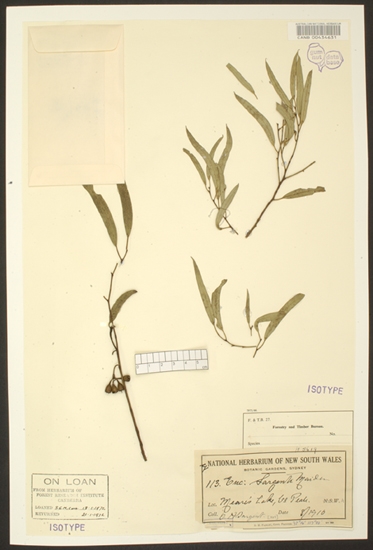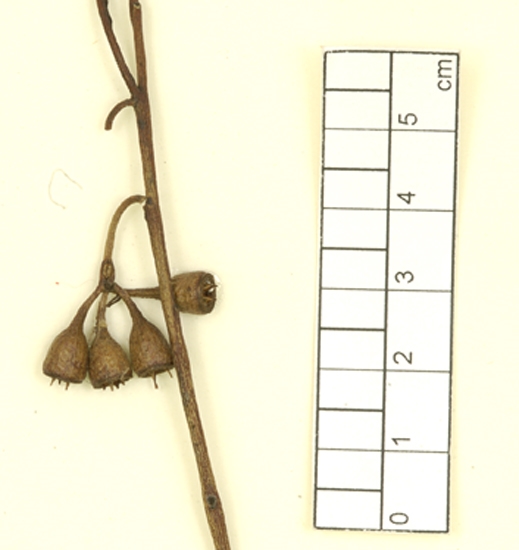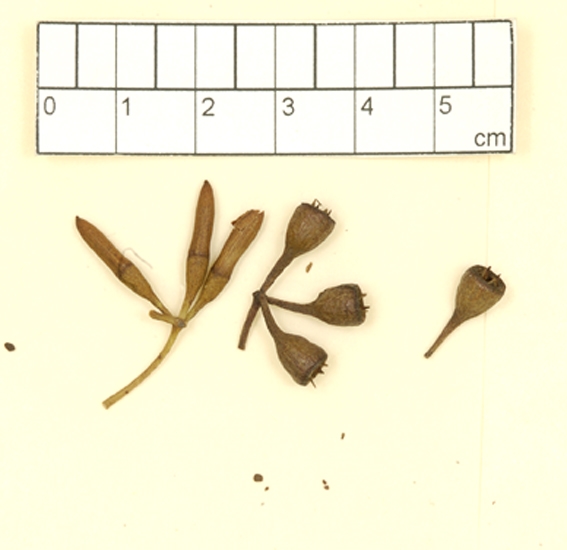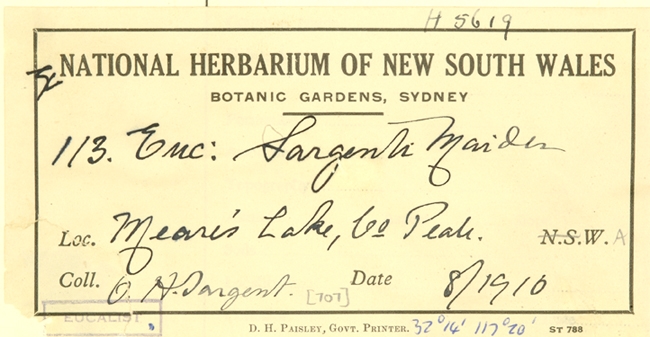Euclid - Online edition
Eucalyptus sargentii subsp. sargentii
Eucalyptus | Symphyomyrtus | Bisectae | Glandulosae | Erectae | Pedicellatae
T: near Meares Lake, County Peale Beverley, W.A., Sept. 1910, H. St Barbe More s.n. (Sargent 707); holo: NSW; iso: ?CANB. [correction to holotype specimen locality and collector fide L.Stanberg & P. Wilson, National Herbarium of New South Wales, Sydney. The purported CANB isotype is dated "8/1910" and lacks any mention of H. St Barbe More as collector, citing O.H.Sargent as collector with the collector number [707] being added later.]
Bark rough over part or all of trunk, grey to black and coarsely flaky and crumbly, rarely smooth throughout; smooth bark greenish-grey over pinky brown.
Branchlets have oil glands in the pith.
Juvenile growth (coppice or field seedlings to 50 cm): stems rounded in cross-section; juvenile leaves always petiolate, alternate, linear to narrowly lanceolate, 5–12 cm long, 0.5–1.3 cm wide, dull, grey-green.
Adult leaves alternate, petioles 0.5–1.8 cm long; blade linear to narrowly lanceolate or falcate, 5.3–12.5 cm long, 0.5–1.3 cm wide, base tapering to petiole, margin entire, apex pointed, concolorous, slightly glossy, green, side-veins acute, reticulation sparse but clear, intramarginal vein close to margin, oil glands numerous, island.
Inflorescence axillary unbranched, erect, spreading or more or less pendulous, peduncles slender, not flattened, 0.7–2 cm long buds 7, pedicellate (pedicels 0.3–0.6 cm long). Mature buds elongated-ovoid and slightly curved, 1.6–2.6 cm long, 0.4–0.5 cm wide, scar present or obscure (outer operculum shed very early), outer operculum horn-shaped, ca twice the length of the hypanthium, stamens erect, anthers versatile, dorsifixed, dehiscing by longitudinal slits, style long and straight, stigma rounded, locules 3 or 4, the placentae each with 4 vertical rows of ovules. Flowers whitish to pale lemon.
Fruit pedicellate (pedicels 0.2–0.5 cm long), usually obonical, 0.6–0.9 cm long, 0.5–0.8 cm wide, disc level at first then descending, valves 3 or 4, at rim level or slightly exserted.
Seeds blackish brown, 0.7–2 mm long, ovoid to flattened-ovoid, dorsal surface shallowly reticulate, hilum ventral.
Cultivated seedlings (measured at node 10): cotyledons Y-shaped (bisected); stems rounded in cross-section; leaves always petiolate, opposite for 2 or 3 nodes then alternate, linear to narrowly lanceolate, 4.5–8 cm long, 0.5–1.5 cm wide, dull, grey-green.
Flowering has been recorded in October and November.
Eucalyptus sargentii is a small tree (mallet) or mallee, of scattered distribution in the Western Australian wheatbelt, from Pithara south-east to the Lake Grace region. It is always associated with salt lakes and salt creeks. The basal bark of the mallets is usually rough grey-black, rarely entirely smooth. The mallees have entirely smooth bark or sometimes a short stocking of rough bark. Adult leaves are small, narrow, slightly glossy, olive-green to green and have side-veins visible. The clusters of elongated buds are borne on slender peduncles.
There are two subspecies:
E. sargentii subsp. sargentii
The more widespread subspecies occurring throughout the species range. It is a tree (mallet) that lacks a lignotuber. It usually has a prominent black butt and grows near many of the salt lakes of the wheatbelt. Trees in the area between Kondinin, Yealering and Corrigin in the southern Wheatbelt may be entirely smooth-barked, or partly rough-barked (fide Peter White, Narrogin, WA).
E. sargentii subsp. onesia
Mallee form restricted to the central wheatbelt from just south of Cunderdin and Meckering north to Carani and Piawaning. The mallees (i.e. they have a lignotuber) have entirely or predominantly smooth bark shedding in ribbons, but in foliar and floral features the plants resemble subsp. sargentii.
Eucalyptus sargentii belongs in Eucalyptus subgenus Symphyomyrtus section Bisectae subsection Glandulosae because the buds have an operculum scar, cotyledons are bisected and branchlets have oil glands in the pith. Within this large subsection (ca 80 species) Eucalyptus sargentii is closely related to a group of mallees and mallets (series Erectae subseries Pedicellatae) recognised by the glossy green leaf surface, leaves with many oil glands but not obscuring the secondary venation, peduncles long and flattened or terete, inflorescences spreading and buds with a long operculum and erect stamens arising from a narrow staminophore.
Eucalyptus sargentii is the only species in subseries Pedicellatae adapted to saline conditions and this combined with the slender, spreading to down-turned peduncles, smooth (non-striate) buds and obconical fruit, distinguish it from its near relatives, viz. E. stowardii, which has larger longitudinally striate buds, smooth bark and occurs on granite soils; E. diminuta, which also has striate buds, smooth bark and occurs on rocky breakaways and sandy sites near soaks; and the more widespread tree E. occidentalis, with basal rough bark, flat peduncles, campanulate fruit and broad juvenile leaves, which is found on low-lying, non-saline sites.
Nicolle (2005) clarifies the habit of plants at the type locality of E. sargentii, Mears Lake, south of Quairading, stating that they are "non-lignotuberous, obligate-seeder" i.e. mallets, not mallees.
Both subspecies are effective in salinity reclamation.

